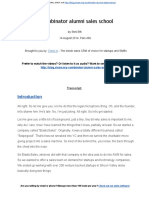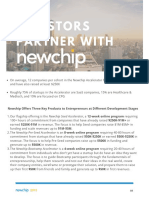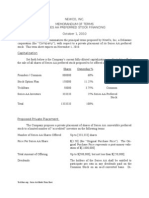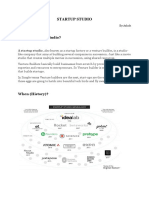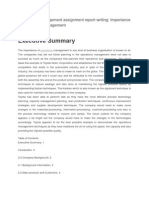LetsVenture pre-funding guide
LetsVenture
Indias most trusted marketplace for
Startups and Investors
Confidential Information
�Do I need to raise a seed round?
Rapid
growth
is
what
makes
a
company
a
startup
Take
outside
money
if
and
only
if
it
will
help
you
grow
faster
Dont
raise
money
if,
You
dont
want
to
grow
faster,
or
Outside
money
will
not
help
you
grow
faster,
or
If
you
wont
be
able
to
convince
investors.
Every
instance
you
raise
money,
you
dilute
your
holdings
geCng
tracDon
is
not
just
about
geCng
funding,
it
is
your
negoDaDng
tool
Takeaway:
Do
not
raise
money
unless
you
want
it
and
it
wants
you.
--Paul
Graham
(YC)
Recommended
reading:
Blog
post
by
Paul
Graham,
Y-Combinator
founder
�When should I raise funds?
Fundraising
is
a
full
Dme
job
Do
not
get
into
fundraising
if
you
think
your
business
will
suer
Pitching
takes
Dme
NegoDaDon
takes
Dme
Ideally,
once
you
have
at
least
Proof
of
Concept.
Investors
do
not
favor
startups
at
IdeaDon
stage.
TracDon
speaks
loudest
Get
beta
out
(MVP)
Show
growth
Show
ability
to
execute
Takeaway:
Beta
>
PoC
PoC
>
IdeaDon
Fundraising
can
impact
your
startups
growth.
Do
not
start
unless
you
are
completely
ready.
Recommended
reading:
Blog
post
by
Marker
Davis,
CEO,
Kohort
&
VC
Running
Lean
by
Ash
Maurya
�How much do I raise?
Not
too
liYle,
and
not
too
much
either
Raise
enough
to
reach
a
criDcal
milestone
Where
you
create
a
entry
barrier
for
compeDDon,
and/or
Can
raise
more
money
at
beYer
valuaDon
Typically,
seed
round
should
last
you
18-24
months
with
conservaDve
spending
Probability
of
having
unaccounted
expenses
is
always
1,
be
sure
to
double
check
your
spending
plan
Takeaway:
Fundraising
is
incremental
process.
You
only
need
enough
to
reach
next
criDcal
milestone.
Raise
as
much
as
you
can.
Without
giving
away
control,
and
without
being
insane.
-
March
Andressen
There
are
downsides
to
raising
too
much
money.
-
March
Andressen
Recommended
reading:
Blog
post
by
ShanD
Mohan,
founder
@
LetsVenture
Blog
post
by
Marc
Andressen
�How much do startups typically raise?
�Milestones, Valuations and Raises?
Milestone
/
Stages
Age
Revenue
Raise
Amount
From
Whom
Venture
launched
0
0.5
5
25
L
Self,
friends
and
family
Beta
Product
launched
B2C:
Product
used
by
real
customer,
few
paying
customers
B2B:
Good
customer
pipeline,
1-2
customers
in
trial
0.5
1
yr
Small
amount
25L
75L
Self,
friends
and
family,
Individual
Angels,
Accelerators
Stable
version
Regular
customer
growth
1
1.5
yr
10
15
L
per
50
L
year
1.5
Cr
Self,
Accelerators,
Seed
Funds,
Individual
Angels
Product
market
t
found
Strong
and
Consistent
customer
growth
Clear
product
and
revenue
for
next
2-3
yrs
1
2
yr
20
50
L
per
1
Cr
4
Cr
year
Individual
Angels,
Seed
Funds,
Few
Venture
rms
Business
model
t
found
Clear
growth
path
for
next
3-5
yrs
Consistent
growth
in
paying
customers
PotenDally
breakeven
1.5
3
yr
2
5
Cr
per
year
Venture
Funds
3
Cr
20
Cr
�What is dilution over lifecycle?
Year
Start
IniDal
Hires
Seed
Round
Create
Pool
VC
Round
Pool
Refresh
2nd
VC
round
Founders
100%
90%
68.4%
59.9%
44.9%
43.2%
32.4%
Seed
Investors
0.0%
0.0%
24.0%
21.0%
15.8%
15.2%
11.4%
IniDal
VC
Investors
0.0%
0.0%
0.0%
0.0%
25.0%
24.1%
18.1%
Later
VC
Investors
0.0%
0.0%
0.0%
0.0%
0.0%
0.0%
25.0%
Early
Employees
+
Advisors
0.0%
10.0%
7.6%
6.7%
5.0%
4.8%
3.6%
Employee
Pool
0.0%
0.0%
0.0%
12.5%
9.4%
13.0%
9.8%
Total
100%
100%
100%
100%
100%
100%
100%
Recommended
reading:
Funding
Fundamental
by
Manish
Singhal
�What are different types of investors?
Source
of
investment,
Accelerators
/
Incubators
Angle
Investors
Seed
funds
Investors
can
be
classied
into
7
types,
Connectors,
Product
people,
TacDcians
and
Builders,
Smart
Business
People,
Domain
Expert,
The
Brand,
The
Filler
(aka
Dumb
Money)
Takeaway:
Accelerators
/
Incubators
may
be
a
good
opDon
before
you
approach
angel
investors
and
seed
funds.
You
want
to
be
in
a
posiDon
to
be
able
to
choose
investors.
Know
your
investors
and
be
sure
why
you
are
bringing
them
on-board.
Recommended
reading:
Blog
post
by
Elad
Gill
�Angels or VCs?
InsDtuDonal
Money
beats
Individual
Money,
unless
VC
is
not
adding
any
value
apart
from
money,
or
A
pro-acDve
Angel
is
a
ready
to
get
on-board
If
a
VC
invests
in
your
seed
round
but
doesnt
follow
through
in
Series
A
it
may
send
negaDve
signal
Not
every
VC
likes
to
parDcipate
in
another
VC
in
Series
A,
potenDal
signaling
issues
There
are
sector
specic
funds
here
VCs
add
a
lot
more
value;
if
you
are
in
niche
market
then
look
out
for
them
Takeaway:
Super
Angels
maybe
a
beYer
choice
than
a
VC
rm.
Take
on
a
VC
rm
if
they
are
adding
more
value
than
just
money.
Typically,
angel
investors
with
their
domain
experience
maybe
beYer
choice.
In
case
you
do
opt
for
a
VC
then
have
strategy
in
place
to
handle
signalling
issues.
Recommended
reading:
Yet
another
blog
post
by
Chris
Dixon
�How do I choose a angel investor?
Look
for
domain
experts,
tacDcians,
smart
business
people,
connectors
and
product
people
But
most
importantly,
look
for
like
minded
investors
who
understand
you,
your
startup
and
what
you
are
out
to
do
Fewer
investors
are
beYer
than
many,
but
not
necessarily
Your
rst
objecDve
should
ideally
be
to
look
for
a
lead
investor,
introducDons
maYer
as
you
reach
out
to
more
investors
Do
a
reference
check
speak
to
companies
they
have
already
invested
in
Takeaway:
Smart
Money
>
Dumb
Money
Dumb
Money
>
No
Money
Fundraising
is
not
just
about
numbers,
it
is
also
about
the
intangibles.
Many
a
Dmes,
intangibles
maYer
a
lot
more
than
expected.
Recommended
reading:
Blog
post
by
Ankit,
Co-founder
@
Adpushup
Adpushup
used
LetsVenture
for
its
fundraise.
�How do I connect with investors?
Network
Reach
out
to
college
alumni
networks
Check
if
there
are
angel
investors
in
your
alumni
network
Reach
out
to
fellow
entrepreneurs
introducDons
will
save
your
Dme
and
energy
Oer
value
to
people
you
meet
make
meeDng
you
worth
their
Dme
Leverage
plamorms
like
LetsVenture,
LinkedIn
to
reach
out
to
individuals
and
groups
you
wouldnt
have
access
to
Cold
emails
work
keep
them
simple,
straight
and
exciDng
Takeaway:
Nobody
will
marry
you
the
rst
Dme
they
meet
you,
if
they
do/did
then
know
it
is
a
excepDon!
It
is
true
for
money
too.
Build
relaDonships.
Follow-up
on
conversaDons.
Send
updates.
Investors
may
need
Dme
to
decide
if
they
want
to
invest.
Some
may
come
back
for
your
next
round.
Recommended
reading:
Blog
post
by
Elad
Gill
Blog
post
by
Steve
Blank
�How do I follow-up and schedule meetings?
Create
a
target
list
of
investors
and
break
them
up
into
3
groups
C
Most
likely
will
not
invest
(start
with
them)
B
Those
you
may
or
may
not
invest
(ne
tune
your
pitch)
A
Dream
list
(meet
them
last,
give
killer
pitch)
Follow
up
politely
but
persistently
Read
between
the
lines
not
everyone
says
No
directly
It
is
a
funnel
process
you
may
meet
30
and
have
follow-up
with
10,
and
only
2
may
invest.
It
is
okay
to
get
rejecDon,
be
persistent
and
paDent.
Takeaway:
Fundraising
is
a
funnel
process.
You
will
meet
100
but
not
everyone
will
commit
to
your
fundraise.
Approach
your
dream
list
only
when
you
are
condent
about
your
preparaDon.
Be
polite,
condent
and
persistent.
Most
of
all,
be
paDent.
Recommended
reading:
Blog
post
by
Cheryl
Yeoh,
CEO
MaGIC
�What is the fundraising process like?
Takeaway:
If
you
wait
unDl
you
are
ready
to
be
funded
then
it
is
too
late.
Fundraising
is
a
process
which
can
take
4-6
months.
Before
you
being
asking
for
money,
create
contacts
and
open
communicaDon
channels.
Get
a
clear
understanding
of
Term
Sheets,
SHA
and
due
diligence
(DD)
process.
Recommended
reading:
Blog
post
by
Sunil
Rajaraman,
Co-founder
@
Scipted.com
Blog
post
by
ShanD
Mohan,
founder
@
LetsVenture
�What financing terms should I know?
Termsheet
Equity
or
ConverDble
notes
LiquidaDon
Preference
AnD
DiluDon
Clause
OpDon
Pool
Board
composiDon
Shareholding
Agreement
Founders
Agreement
Remember
termsheet
is
a
non-binding
document.
Takeaway:
Before
you
get
into
a
room
understand
the
termsheet
and
SHA
clearly.
Have
a
founders
agreement
in
place
to
ensure
there
no
bad
blood
later.
Read
every
line
of
every
document.
Ask
if
you
have
any
doubt.
Recommended
reading:
Standard
Termsheet
by
ShanD
Mohan,
founder
@
LetsVenture
On
importance
of
founders
agreement
from
Yourstory
�What are investors looking for?
Business
(not
an
idea!)
Nobody
has
monopoly
on
a
idea
The
Team
Can
you
execute?
Can
you
adapt?
Are
you
coachable?
Easy
to
talk
to?
Risk
Management
Plan
Key
is
to
talk
about
the
potenMal
risks
for
your
business
and
more
importantly
your
acMon
plan
towards
miMgaMng
them
Clean
Structure
and
Governance
Clear
and
unambiguous
record
of
in-house
IP
Simple
holding/ownership
structure
Exit
Plan
Key
is
to
talk
about
your
intenMon
to
provide
an
exit
to
investors!
�What do investors ask?
Everything.
Prepare,
prepare
and
prepare
In
case
you
do
not
have
a
answer
be
honest
and
be
proacDve
in
geCng
back
with
answers
and
insights.
Takeaway:
Expect
lots
of
quesDons.
Prepare
and
keep
ne
tuning
your
answers.
Keep
it
simple
and
straight.
QuesDons
will
also
help
you
ascertain
what
sort
of
investor
a
person
is
(smart
money
or
dumb
money).
Recommended
reading:
Blog
post
by
Elad
Gill,
with
contribuDon
from
Satya
Patel
�How do I make perfect deck?
Follow
Guy
Kawasakis
10/20/30
rule
10
slides
20
minutes
30
point
font
Takeaway:
Investors
may
spend
only
4-5
Min
on
your
deck.
They
are
short
on
Dme,
hold
their
aYenDon.
Follow
of
informaDon
is
important,
not
just
headings.
Break
your
Dme
into
5-15-30min
-
5
min
to
get
aYenDon
for
next
15
min,
and
which
in
turn
will
keep
their
aYenDon
for
30
min.
Recommended
reading:
Research
Deck
by
DocSend
team
10/20/30
Rule
by
Guy
Kawasaki
�How do I run investor meeting?
Prepare
with
your
sponsor,
you
are
a
team
as
you
enter
that
room
be
in
sync
with
your
sponsor
and
co-founders
Setout
the
mandate
before
you
begin
Nail
them
in
opening
minutes
Pitch
your
product
and
vision
execuDon
>
team
>
idea
Pitch
your
ability
to
build
Before
you
end
the
meeDng,
setout
Dmeframe
for
follow-up
and
next
meeDng
Takeaway:
AYenDon
span
drops
with
Dme.
Keep
it
simple,
straight
and
precise.
Investors
want
to
see
if
you
can
deliver,
that
is
execute
a
idea.
Break
your
Dme
into
5-15-30min
-
5
min
to
get
aYenDon
for
next
15
min,
and
which
in
turn
will
keep
their
aYenDon
for
30
min.
Recommended
reading:
Blog
post
by
Aaref
Hilaly,
Sequoia
CapDal
Blog
post
by
Chris
Dixon,
a16z
�Do I need a lawyer?
Lawyer
should
be
hired
if
you
are
not
condent
in
your
understanding
of
documentaDon
Go
with
a
experience
startup
friendly
rm
Read
every
word
of
every
legal
document
Use
standardized
documents
when
possible
Do
not
send
lawyers
to
negoDate!
Ask
them
quesDons!
Lots
of
quesDons
Takeaway:
Lawyers
are
there
to
ensure
what
is
discussed
is
translated
on
paper,
and
to
make
you
aware
of
potenDal
pimalls.
Any
lawyer
will
not
do.
Work
with
someone
who
has
startup
experience.
Recommended
reading:
Yet
another
blog
post
by
Elad
Gill
�How do I negotiate on valuation?
It
is
not
just
about
pre-money
and
post-money
valuaDons
It
is
also
about
terms
and
condiDons
set
out
by
investors
Do
not
hesitate
to
ask
investors
to
match
the
best
termsheet
you
have
received
TracDon
is
your
biggest
trump
card,
it
favors
you
and
only
you
Share
data,
get
market
informaDon
where
possible
but
leave
ego
at
the
door
Understand
their
prioriDes
and
that
one
metric
that
maYers
to
everyone,
and
then
chase
that
number
Takeaway:
Terms
and
condiDons
are
very
important,
not
just
the
valuaDon.
TracDon
is
your
best
friend
If
X
gets
$10M
does
mean
you
will
get
it
too,
be
informed
but
leave
ego
at
the
door
Recommended
reading:
Lets
revisit
this
blog
post
by
Sunil
Rajaraman,
CEO
of
Scripted
�How do I get money in bank?
Termsheet
is
not
legally
binding
document
Be
forthcoming
with
informaDon
wherever
asked
Commitment
to
closure
is
a
tedious
process
work
with
service
providers
experienced
in
working
with
startups
Due
diligence
takes
Dme
be
sure
you
understand
the
Dmeline
and
have
factored
it
in
Companies
take
4-12
weeks
to
get
money
in
bank
talk
to
fellow
funded
entrepreneurs
to
understand
process
and
avoid
pimalls
Takeaway:
Job
is
not
done
unDl
money
hits
the
bank.
Dont
think
about
PR
unDl
you
receive
the
funds.
Due
diligence
is
Dme
consuming
process
but
one
can
save
Dme
by
working
with
experienced
service
providers
/
teams.
Recommended
reading:
TechCrunch
arDcle
by
Anthemos,
CEO
of
Zumper
�How do I work with my investors?
You
have
money
in
bank,
and
you
are
already
on
your
way
to
next
fundraise
Second
seed
round,
or
Series
A
Update
your
investors
on
weekly/monthly/quarterly
basis
be
proacDve
and
be
available
Spend
Dme
with
them,
get
to
know
them
beYer
-
relaDonships
are
important
Ask
help!
if
needed
Takeaway:
You
have
spent
Dme
to
nd
investors.
Now
spend
Dme
to
strengthen
these
relaDonships.
Put
your
investors
to
work
for
you
everyone
has
a
interest
in
your
growth.
Be
proacDve
with
updates.
Be
humble,
condent
and
paDent.
Recommended
reading:
Yet
another
blog
post
by
Elad
Gill
(Ps:
dont
you
just
love
his
posts!)
�How do I create a Board?
Keep
it
small
Choose
wisely,
you
dont
want
to
rush
on
this
Seek
experience
to
supplement
your
own
Takeaway:
Like
minded
board
members
who
supplement
your
skills
and
do
not
shy
away
from
poinDng
out
faults
while
supporDng
you
on
course
correcDon.
Recommended
reading:
Yet
another
blog
post
by
Elad
Gill
along
with
yet
another
blog
post
by
Chris
Dixon
(Ps:
promise
these
are
last
two
links)
�Thank you
In
case
you
have
a
query,
please
write
to
startups@letsventure.com

